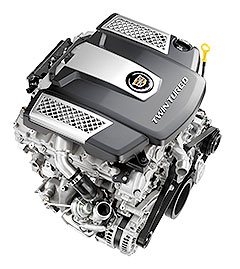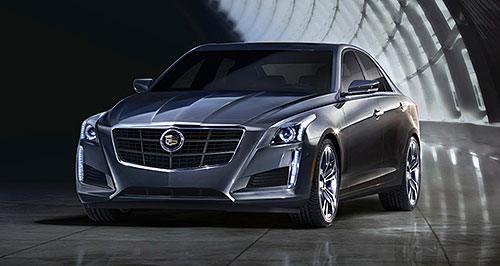Make / Model Search
News - CadillacNew York show: Holden link to GM’s twin-turbo V6Tickled pink: Holden strapped twin turbos to a General Motors 3.6-litre V6 engine for the Torana TT36 concept nine years before Cadillac made an even more powerful version production reality. Cadillac looked to 2004 Holden Torana TT36 concept when developing twin-turbo V628 Mar 2013 By HAITHAM RAZAGUI in NEW YORK HOLDEN’S 2004 Torana TT36 concept provided some inspiration to engineers working on the thumping new Cadillac twin-turbo V6 petrol engine. The engine’s assistant chief engineer Richard Bartlett told GoAuto the Torana’s 3.6-litre twin-turbo V6 engine was among the forced-induction applications considered when researching methods of boosting the venerable GM LFX V6. “Yes we looked around and we have also done spins here in the US off the same architecture with twin-turbo aftermarket systems and we looked at how people integrate things,” he said. “In those applications typically packaging and mass are not a big consideration ... but certainly the concept of twin-turbocharging, what they learned feeds into what we selected for here as well.” The V8-bashing six-pot just debuted under the bonnet of Cadillac’s all-new rear-drive CTS luxury sedan at the New York motor show. Although Mr Bartlett would not be drawn on specifics outside the Cadillac brand – the next car to receive the engine will be the Cadillac XTS large SUV – it promises to eventually deliver searing performance across the wider General Motors empire. “It’s remarkably space efficient, it’s not really heavy mass-wise, the output is scalable with calibration so there is certainly potential to do other things than what we are offering here today,” he said.  “It’s a very compact efficient design, it mounts transversely and longitudinally and it has compatibility with a lot of options – but today we’re talking about CTS.” In the CTS – in which the new engine pumps out an HSV V8-chasing 313kW and 583Nm – the turbo V6 heralds the arrival of a new V Sport sub-brand to sit below V8-powered performance flagship Cadillacs bearing the V designation. Mr Bartlett revealed that the engine’s output is scalable – for example the torque output will be reduced to 500Nm and transverse-mounted in the XTS – and there is room to boost it beyond the already impressive figures of the CTS V Sport. “We can calibrate these things though software we haven’t put any numbers out there that show extension on the engine but there certainly is extension there,” he said. The CTS V Sport engine is related to the Australian-built 3.6-litre LY7 powerplant used in the Holden Commodore SV6 but heavily modified to suit forced-induction. North America was wholly responsible for developing the twin-turbo conversion but Mr Bartlett mentioned that some members of his team work on the LFX/LY7 engine programme, meaning they have regular interaction with Fishermans Bend, especially in the area of engine calibration. “We interact quite a bit, we share software and controllers and of course the engine design,” he said. Asked whether GM developed the engine in response to Ford’s successful EcoBoost programme, he said that success was largely down to the volume-selling F150 truck, in which low speed torque for towing or dealing with heavy loads is the priority while the Cadillac engine was “architected specifically for luxury performance and excitement”. “The CTS with the eight-speed transmission is harmonised with how we optimised the compression match within the turbochargers, the torque converter, the gear set, the final drive – it was all focussed on the CTS application.” Cadillac estimates the twin-turbo CTS V Sport can crack 0-97km/h in 4.6 seconds. The Torana TT36 concept produced 280kW and 480Nm – 10kW more powerful but 50Nm down on the 6.0-litre V8 in today’s Commodore SS. Holden has no current plans to deploy the new twin-turbo V6 engine in the VF Commodore that will launch in a few months.  Read more26th of March 2013  Siri to talk to Commodore driversHolden matches Siri to Barina, while models including VF Commodore line up19th of March 2013  New York show: Turbo GM V6 out-punches HSV V8No current plan for Holden to adopt bahn-storming new Cadillac twin-turbo V6 engine |
Click to shareCadillac articlesMotor industry news |











Facebook Twitter Instagram